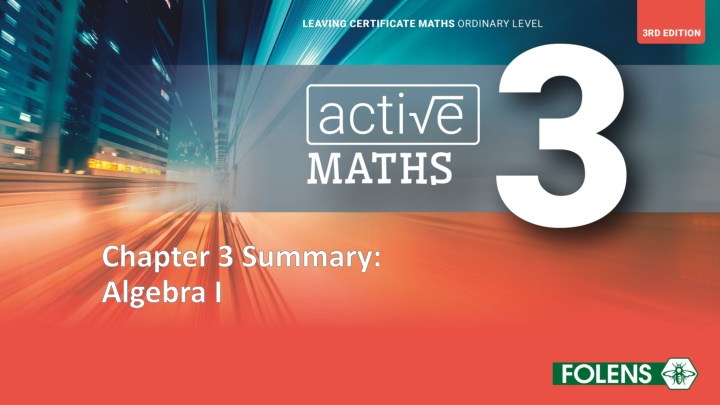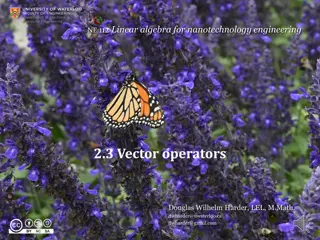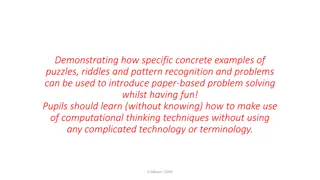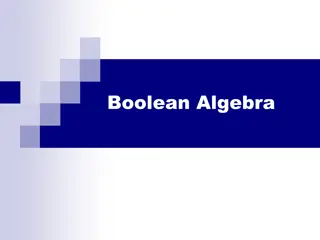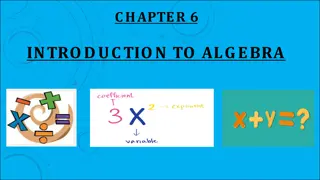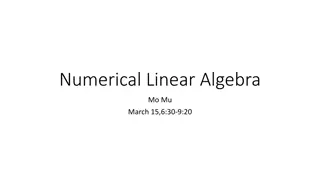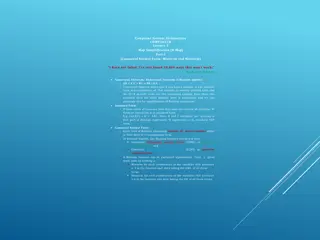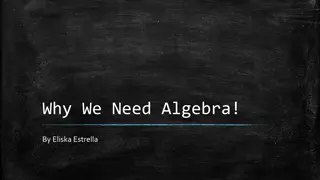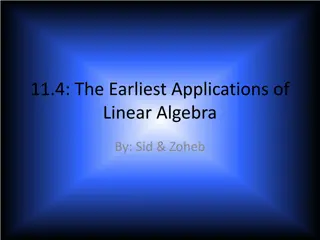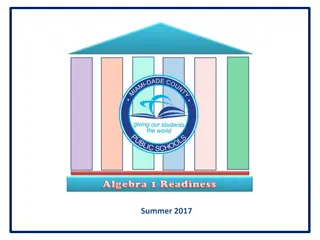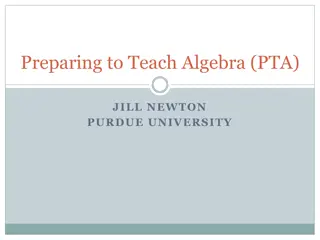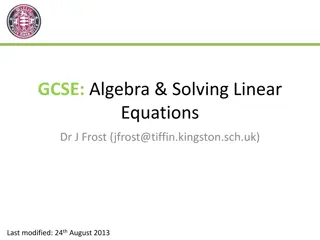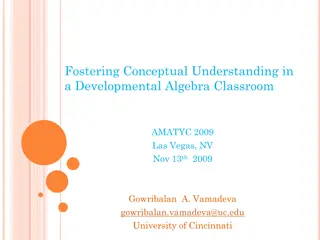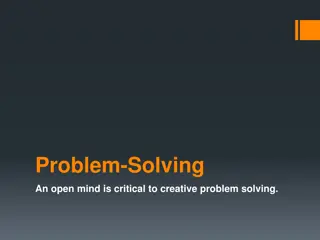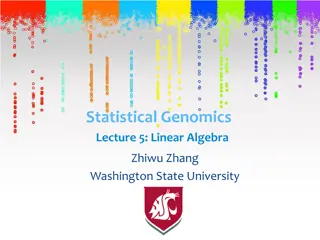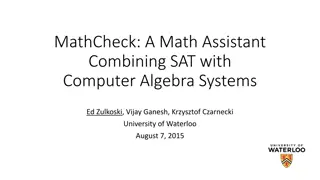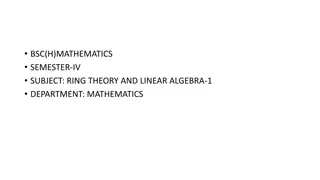Algebra: Key Concepts and Problem-Solving
Algebra plays a crucial role in various fields, from designing computer games to modeling weather patterns. Mastering the rules of basic algebraic operations is essential for adding, subtracting, multiplying, and dividing terms and expressions. By learning key words and concepts like variables, coefficients, and factorizing, you can effectively solve problems and represent real-life situations mathematically. Remember to follow the correct order of operations (BIMDAS) and ensure your solutions align with the context of the question.
Download Presentation

Please find below an Image/Link to download the presentation.
The content on the website is provided AS IS for your information and personal use only. It may not be sold, licensed, or shared on other websites without obtaining consent from the author.If you encounter any issues during the download, it is possible that the publisher has removed the file from their server.
You are allowed to download the files provided on this website for personal or commercial use, subject to the condition that they are used lawfully. All files are the property of their respective owners.
The content on the website is provided AS IS for your information and personal use only. It may not be sold, licensed, or shared on other websites without obtaining consent from the author.
E N D
Presentation Transcript
Chapter 3 Summary: Algebra I
Chapter 3: Key words Variable Coefficient Constant Factorising Term Like terms Algebraic expression
3.1 Expressions Algebra has many uses, from the design of computer games to the modelling of weather patterns. To be able to use algebra, we must first understand the rules involved in the basic operations of adding, subtracting, multiplying and dividing algebraic terms and expressions. There are various words that we use when discussing algebra, and it s important that you know these words, and understand how to use them in the context of algebra.
3.1 Expressions One of the main uses of algebra is to solve problems. Information is given in a real life context using words and/or diagrams. You use algebra to represent this information mathematically. This usually involves writing an algebraic equation (or equations) that can then be solved, giving us the answer (or answers) required.
3.1 Expressions When answering any problem-solving question we should always: Be careful of the units in any measurements used in the question, and especially in the answer. Make sure that we have clearly defined the meanings of any letters (variables) used. Check that our answer makes sense in the context of the question. For example, the length of a rectangle cannot be 8 cm or 8 kg.
3.1 Expressions Review Worked Examples 3.1 to 3.4.
3.2 Evaluating Expressions One of the many cases where we encounter algebra is when we are given a formula and asked to substitute in certain values. This requires us to replace the variables with the numerical values given. We must always remember to follow the correct order of operations (i.e. BIMDAS).
3.2 Evaluating Expressions BIMDAS These letters stand for: Brackets Indices Multiplication Division Addition Subtraction
3.2 Evaluating Expressions BIMDAS Brackets come first
3.2 Evaluating Expressions BIMDAS Then indices (powers/roots)
3.2 Evaluating Expressions BIMDAS Next multiplication/ division
3.2 Evaluating Expressions BIMDAS Finally addition/ subtraction
3.2 Evaluating Expressions BIMDAS
3.2 Evaluating Expressions BIMDAS: Example
3.2 Evaluating Expressions BIMDAS: Example
3.2 Evaluating Expressions BIMDAS: Example
3.2 Evaluating Expressions BIMDAS: Example
3.2 Evaluating Expressions BIMDAS: Example
3.2 Evaluating Expressions BIMDAS: Example
3.2 Evaluating Expressions Review Worked Examples 3.5 to 3.6. An animated Worked Example 3.6 is on the following slide.
3.2 Evaluating Expressions If ? = ? and ? = ?, evaluate the following expressions: ??+?? ?? ?? ? (iii) ?? + ??? (i) ??? ??? (ii) 3?+4? 5? 2? 2 (i) 2?2 2?3 2? + 3?2 (ii) (iii) = 2(3)2 2( 1)3 = 2(3) + 3( 1)2 3(3)+4( 1) 5(3) 2( 1) 2 = = 2(9) 2( 1) = 6 + 3(1) = 18 + 2 9 4 = = 6 + 3 15+2 2 = 20 = 5 15 = 9 = 3 = 1 3
3.3 Simplifying Expressions Adding and Subtracting Terms When adding or subtracting algebraic terms, we must pay attention to like terms. These are terms that have the exact same letter(s) raised to the same power(s). For example, x, 4x and 10x are like terms, but x and 4x2 are not, because they have different powers of x.
3.3 Simplifying Expressions Adding and Subtracting Terms There are two rules that we must always remember when we are adding or subtracting like terms:
3.3 Simplifying Expressions Adding and Subtracting Terms There are two rules that we must always remember when we are adding or subtracting like terms:
3.3 Simplifying Expressions Review Worked Example 3.7. An animated Worked Example 3.7 (ii) is on the next slide.
3.3 Simplifying Expressions Simplify: ?? ?? ?? + ? ?? + ??? Addition and Subtraction: Only like terms can be added or subtracted. ?2 2? 10 + 4 3? + 4?2 = ?2+ 4?2 2? 3? 10 + 4 = 5?2 5? 6
3.4 Expanding Expressions We may have to deal with multiplying an expression by a number or a term. The distributive property of real numbers is used to simplify expressions involving brackets:
3.4 Expanding Expressions However, we can use the fact that multiplication distributes over addition and subtraction to help find an alternative way to do this calculation. For example:
3.4 Expanding Expressions However, we can use the fact that multiplication distributes over addition and subtraction to help find an alternative way to do this calculation. For example:
3.4 Expanding Expressions Review Worked Examples 3.8 to 3.9. An animated Worked Example 3.9 (i) is on the following slide.
3.4 Expanding Expressions Remove the brackets and simplify: ? + ? ? ? Method 1 Method 2: Area model ? + 2 ? 3 When using the area model we add the areas of the smaller rectangles. = ? ? 3 + 2(? 3) ? + 2 ? 3 = ?2 3? + 2? 6 Adding gives ? ? +2 = ?2 ? 6 ?2 +2? ? 3 3? 6 ?2 ? 6
3.5 Factorising Expressions Another important skill is finding the factors of an expression. This is called factorising. It is the reverse of expanding. To factorise an expression, we rewrite the expression as a product. A product is two or more terms that, when multiplied together, will give the original expression. For example, 5 and 7 are factors of 35 because 5 7 will give us 35. The product in this case is 5 7.
3.5 Factorising Expressions As another example, for the expression 5x + 10, 5 and (x + 2) are factors as 5(x + 2) = 5x + 10. In this case, 5(x + 2) is the product. Remember to always factorise each expression fully.
3.5 Factorising Expressions You will have already met the following methods of factorising at Junior Cycle level:
3.5 Factorising Expressions You will have already met the following methods of factorising at Junior Cycle level:
3.5 Factorising Expressions You will have already met the following methods of factorising at Junior Cycle level:
3.5 Factorising Expressions You will have already met the following methods of factorising at Junior Cycle level:
3.5 Factorising Expressions Highest Common Factor Factorise fully 4??+ ?? 4?2+ 6? = 2?(2? + 3) 2? is the highest common factor for both terms.
3.5 Factorising Expressions Grouping Factorise fully ?? ?? ?? + ?? ?? ?? ?? + ?? = ?? ?? + ( ?? + ??) Group. = ? ? ? ?(? ?) Remove common terms. = ? ? (? ?) Remove common term.
3.5 Factorising Expressions Difference of Two Squares Quadratic Trinomials Factorise fully ???? ????? Factorise fully ?2 2 ? 90 ?2 ? 90 90 25?2 144?2 = (5?)2 (12?)2 = (? 10)(? + 9) Write each term as a square. = (5? 12?)(5? + 12?)
3.5 Factorising Expressions Review Worked Examples 3.10 to 3.13.
3.6 Expressions Involving Fractions When asked to add or subtract two algebraic fractions, we should first find the lowest common denominator (LCD). We then apply a similar method to that of adding/subtracting numerical fractions. The next slide gives an example.
3.6 Expressions Involving Fractions Review Worked Examples 3.14 to 3.16.
3.7 Dividing Algebraic Expressions Simplifying algebraic fractions is very similar to simplifying numerical fractions. When we simplify an algebraic fraction, we need to divide the top (numerator) and bottom (denominator) by their Highest Common Factor (HCF). The following slides give two examples.
